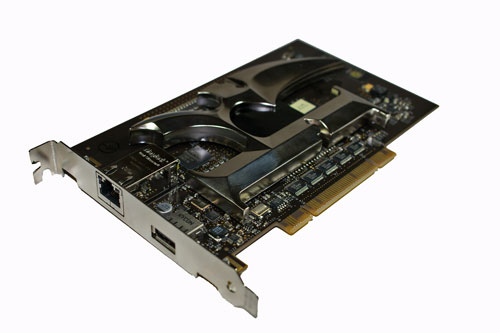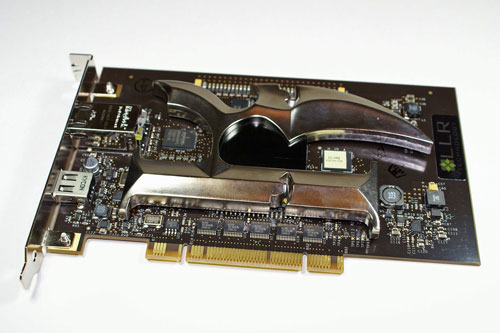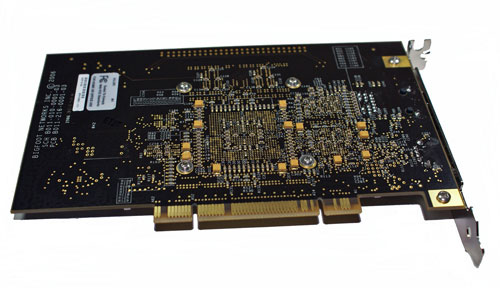BigFoot Networks Killer NIC: Killer Marketing or Killer Product?
by Gary Key on October 31, 2006 2:00 AM EST- Posted in
- Networking
Killer NIC Card
The Killer NIC ships with an installation disc that includes several Linux programs, a few decals, product documentation package, and a full retail copy of F.E.A.R. on DVD.
The Killer NIC is a very interesting card and since the Halloween season is upon us we have to say the thought of removing the "K" heatsink and using it as part of our Blade costume came to mind several different times. The PCB is black in color and contains a significant amount of components that you would never expect to see on a typical NIC. There are also several red LEDs on the PCB whose blinking movements can be adjusted by the control panel. Overall, the card's design theme follows its naming convention.
The card is equipped with a Freescale MPC8347E communications processor, a Xilinx Spartan FPGA, an integrated Broadcom Gigabit PHY, and 64MB of RAM for the embedded Linux build that is accessed by the FNapp Console. The Freescale MPC8347E communications processor is designed for general communications requirements from Ethernet routers to Internet network appliances. The Xilinx Spartan FPGA is a programmable gate array that houses Bigfoot Networks' proprietary and patent pending algorithms that also utilize the 64MB of onboard RAM.

The card utilizes a standard RJ-45 port and includes a USB 2.0 port. The USB 2.0 port is not visible to Windows and is designed to be used by an FNapp. The thought process is that an FNapp can read or write data to a flash drive or external HD. This would be very advantageous for writing data directly to an external hard drive via a BitTorrent type FNapp as one example.
The amount of integrated components along with its basic design features is one of the reasons why this card costs $279.99. This is a price tag that generally puts this card out of reach for most users who are typically satisfied with their NIC's current performance.
The card was very easy to set up. You need to disable your current NIC for optimum performance and compatibility. This is an action that we highly advise after a couple of aborted installs with the original driver set. The card requires a single PCI 2.2 slot and is only compatible with 32-bit Windows XP at this time. After installing the card, a quick reboot, and hardware recognition by XP, you install the driver set off the CD although we highly suggest downloading the latest release first. Another reboot is required and then you are set to use the card for total world domination. Well, at least this is probably your thought process if you read through the marketing material and other documentation online.
Additional 64-bit XP and Linux support is expected within the next six to eight weeks. However, it is still uncertain as to what features will be enabled for Linux and what if any performance benefits will be gained. Windows Vista support should be available by the time the OS ships and it will be interesting to see if there are any improvements considering Microsoft has completely rewritten the network stack code for efficiency and latency reduction. At this point in time there are no plans for a PCI Express version of the Killer NIC. According BigFoot Networks the PCI interface was utilized to improve transactional latencies, programming familiarity, and the fact that most systems have the required amount of PCI slots. We disagree with that last point as the majority of performance oriented boards are now PCI slot starved, and we would expect PCI-E to be a future consideration depending on the success of the current design.
The Killer NIC ships with an installation disc that includes several Linux programs, a few decals, product documentation package, and a full retail copy of F.E.A.R. on DVD.
 |
 |
| Click to enlarge |
The Killer NIC is a very interesting card and since the Halloween season is upon us we have to say the thought of removing the "K" heatsink and using it as part of our Blade costume came to mind several different times. The PCB is black in color and contains a significant amount of components that you would never expect to see on a typical NIC. There are also several red LEDs on the PCB whose blinking movements can be adjusted by the control panel. Overall, the card's design theme follows its naming convention.
The card is equipped with a Freescale MPC8347E communications processor, a Xilinx Spartan FPGA, an integrated Broadcom Gigabit PHY, and 64MB of RAM for the embedded Linux build that is accessed by the FNapp Console. The Freescale MPC8347E communications processor is designed for general communications requirements from Ethernet routers to Internet network appliances. The Xilinx Spartan FPGA is a programmable gate array that houses Bigfoot Networks' proprietary and patent pending algorithms that also utilize the 64MB of onboard RAM.

The card utilizes a standard RJ-45 port and includes a USB 2.0 port. The USB 2.0 port is not visible to Windows and is designed to be used by an FNapp. The thought process is that an FNapp can read or write data to a flash drive or external HD. This would be very advantageous for writing data directly to an external hard drive via a BitTorrent type FNapp as one example.
The amount of integrated components along with its basic design features is one of the reasons why this card costs $279.99. This is a price tag that generally puts this card out of reach for most users who are typically satisfied with their NIC's current performance.
The card was very easy to set up. You need to disable your current NIC for optimum performance and compatibility. This is an action that we highly advise after a couple of aborted installs with the original driver set. The card requires a single PCI 2.2 slot and is only compatible with 32-bit Windows XP at this time. After installing the card, a quick reboot, and hardware recognition by XP, you install the driver set off the CD although we highly suggest downloading the latest release first. Another reboot is required and then you are set to use the card for total world domination. Well, at least this is probably your thought process if you read through the marketing material and other documentation online.
Additional 64-bit XP and Linux support is expected within the next six to eight weeks. However, it is still uncertain as to what features will be enabled for Linux and what if any performance benefits will be gained. Windows Vista support should be available by the time the OS ships and it will be interesting to see if there are any improvements considering Microsoft has completely rewritten the network stack code for efficiency and latency reduction. At this point in time there are no plans for a PCI Express version of the Killer NIC. According BigFoot Networks the PCI interface was utilized to improve transactional latencies, programming familiarity, and the fact that most systems have the required amount of PCI slots. We disagree with that last point as the majority of performance oriented boards are now PCI slot starved, and we would expect PCI-E to be a future consideration depending on the success of the current design.










87 Comments
View All Comments
Gary Key - Tuesday, October 31, 2006 - link
I fully agree the article was probably too long. It was a case of trying to cover all the bases and then some. If we had left out the technology sections and reduced the commentary it would have read better as a basic hardware item. We looked at this as not being your basic NIC review.However, I am sure there would have been comments that we did not properly review the card or provide this same information. Thanks for the comments.
Crassus - Wednesday, November 1, 2006 - link
I agree with the comment above. I would have like an even more expanded page detailing the technology and the roots in the corporate sector. What I didn't really care about was the endless description of the pains it took to benchmark the card.Two things about that:
1. If it was easy, everyone could do it. You (and Anandtech) stand above the crowd for going the extra mile and giving us some added (useful) information. This is usually self-evident and doesn't require elaboration.
2. My firm expects me to get the job done, as, I suppose, it is the same with yours. No one gives a hoot as to all the steps I had to go through to get the job done, unless they offer some added value. Thinking about throwing something out of the window (if you're blessed with having one in your office) occurs to everyone at some point and certainly doesn't hold any additional value - in other words: it comes with the job. If it was otherwise, see (1) above. There's really no need to mention it a couple of times - unless you're reviewing your work instead of the product.
Gary Key - Wednesday, November 1, 2006 - link
I appreciate your comments. I am alawys open to other viewpoints and opinions. What paragraphs contained endless descriptions that in your opinion could have been cut? Email me if you can please.
I agree it comes with the job. The message I was trying to convey was one of total frustration with the product after six weeks of almost non-stop testing. There were several choice words I wanted to use but felt like that statement would be universally understood. ;-)
Sunrise089 - Tuesday, October 31, 2006 - link
I really liked reading the article. When G80 comes out, we can cut strait to the benches, because I'm going to want to know whether or not to buy the card. None of us are going to buy this thing, but we're all enthusiests, so reading about it can still be fun. With performance changes so minor however, adding a little commentrary to spice up the review makes it a lot more entertaining for this reader.Frumious1 - Tuesday, October 31, 2006 - link
I'm in agreement with Sunrise - liked the article and the sarcasm. I can only imagine your pain during the review. Can't believe how many people apparently lack the ability to read and need pictures. "Just give us two paragraphs saying whether or not to buy the card!" Bah! That's what the conclusion page is for, where it's pretty clear the card "works as advertised" which means fractional gains in a few games.Zaitsev - Tuesday, October 31, 2006 - link
"Just give us two paragraphs saying whether or not to buy the card!"The only reason I still read Anandtech is because they do exactly the opposite. In articles like this one and the Conroe review, I think the pages discussing the technology are more interesting than the results. I can't talk from experience, but it also seems that it would get boring for the authors if they just punched out cookie cutter articles for every review.
As for the card, I wouldn't be able to sleep at night if I bought this instead of a Conroe.
michal1980 - Tuesday, October 31, 2006 - link
i can sum in up for you in one line."In most cases the Killer-Nic Does Nothing"
as for windows vista.
it has a total new audio stack that is seperate from the kenernal, so in theory it could run on a core other then the main os kerenal.
Googer - Tuesday, October 31, 2006 - link
FNA is the only thing that makes a killer nic really worthwhile.http://www.extremetech.com/article2/0,1697,2037279...">http://www.extremetech.com/article2/0,1697,2037279...
cryptonomicon - Tuesday, October 31, 2006 - link
Assuming the review quantified "ping measurements" correctly, this thing has a long way to go. If it gave even a consistent 10% faster pings all the time it would be very appealing to pro-gaming. But from those ping charts, the results were truely inconclusive. The side effect of increased FPS was even more significant than any ping reduction.Looking forward to revisions or later models from Bigfoot though!
floffe - Tuesday, October 31, 2006 - link
That's because in most cases 98% of the ping is not on the local computer, but from your internet connection point (DSL/cable modem or whatever) to the server. Tis means even cutting 5% off that will be very hard (in general. WoW seems to be an exception).